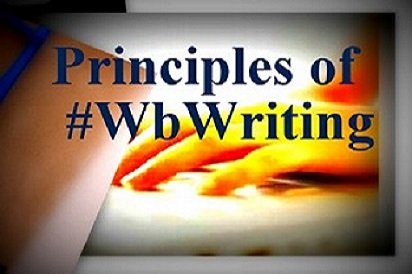What makes Web-Based Writing so special and tough to master? It is certainly not a fear of writing. We have been writing each day and moment of the day now. Our Social Media Writing is different from Professional Writing on the web. It is important to learn the nuances of writing on the Web.
“Think of Web-Based Writing as a Conversation.” Your writing should be Audience-Centred.
Journalism has a concept of reporting the news content: The Inverted Pyramid.

Web-based writing needs the same rules while creating content for the virtual world.
In the inverted pyramid or the upside-down triangle figure, we have three segments. The first one is the Heading Sentence or Phrase, followed by (II) supportive information and then in the last we have (III) other details. It corresponds with the declining interest of a reader, who reads selectively and does not have the inclination to read word by word. We experience it when we read newspapers and magazines, print or even online.
We have already discussed the difference between the virtual and the print media of reading. The purpose or the fundamentals of Web-Based Writing have also been discussed. Now we move on to underline the main Characteristics of Web Content.
We shall deliberate to answer the question: What brings Effectiveness and Brilliance in the Content on the Web? ©EklavyaParv: Learning Content
A Checklist of the components of good content is to be prepared and implemented with utmost concern. People who read online are like movie fans and need to find the content entertaining and interesting, not boring. There can be no compromise about the quality of the content, and this is what calls for an impressive Writing Style. Remember, the ‘user’ can always go to the Right-Hand side Top Corner – X! CLOSE the Web Page, we call this option!
There are choices, and our aim should be to make our website or weblog (Blog) the First!
Basic Principles of Writing: A-B-C: Accuracy, Brevity, and Clarity
- Accuracy in Grammar, Sentence Composition, Syntax, etc
- Brevity in the number of words used, and redundancy to be avoided
- The clarity in Thought and Expression
The ‘Obligatory Elements’ of Web-Based Writing are as follows:
Structure: Make Headings and Sub-Headings Count. Write Short Sentences and Small Paragraphs. Prefer Bullet Points, Links rather than explanatory paragraphs.
Relevant: The content writer should ensure that the content will be of significance for the reader and it will generate a sense of satisfaction in the mind of the visitor. It should make the reader feel that the search was for this content only. Content needs to seem specific to the Persona we imagined while preparing it.
Useful: It seems hard to define, but still, it needs a mention. We can check this feature by doing a comparative study of the content available to your competitors. Practical pieces of advice make it useful, rather than being a moral sermon. It should be phrased in a way that it makes the user ‘Take Action’.
Accurate: The Rules of the Land are to be followed while writing web content. This is a way to make the readers feel that you follow standards in writing. Ensure that the content is trusted by the user. Still, the user may pick something that seems true and may damage your reputation. Hence, we must have the expertise to write on that specific subject, cross-check the data, make sure that spelling and grammar are checked, and there are no typos.
Credible: Your content will be credible if you have the facts. If you are not sure, don’t move ahead with the writing on a certain topic. The content writer cannot mention ‘T & C Apply’ and shun accountability. If you are not sure, go and talk to the experts; be humble and enhance your learning. Making your content Trustworthy and Believable is your responsibility.
Findable: The content reader has to be made comfortable in finding the content. There are various ways to reach the content; one way is that they come to your website and get the content. But it looks less possible in this age of a million websites. You need to improve the findability of your content. Help them find it by using the Searchable and Preferred Terms in the content. Labels should help them understand what the content talks about. The users may not use the navigation to go to the content on the website. Links within your website should bring the users to related content. It makes access easy and proficient.
Current (Real-Time Updating): “At the time of going to the press, Brazil was at…” How does it sound to a football lover, who was awake all night? In the morning, the newspaper is still baking the stale information to him! This is what we can’t afford in Web-Based Writing. We live in a Real-Time World. Even the web portals of the newspapers update information every minute. The least a reader/user wants is that the content is not updated and has expired. The content has to be reviewed at regular intervals, though updates are needed only when it is required. For the news content, update it every minute, but the same for the ‘Exam Results’ is not welcome. However, the train timetable needs real-time updates.
Consistent: If there is more than one content writer for the website/blog, it should be checked that they are in sync with the style of writing. The words, acronyms, syntax, and abbreviations are to be in harmony with both individuals. The style with which the content category started should be maintained.
Scannable: Hope you remember the ‘F’ shaped scanning pattern of the online readers. Arrange the content in that pattern. Facilitating the comfortable scanning of the content makes a Headline with eight to ten words or even less. The Subheadings are nice things to support the heading. The sentence can be limited to 15-20 words each. And do remember that a sentence is the manifestation of a complete thought. Hence ONE Thought-ONE Sentence! Remember that each paragraph explains one idea and can have 50-70 words.
Interesting: Going by the objective of communication, as well as web-based writing, we should remember that we communicate by our tone of voice, too. Make a Conversation. Try to avoid the use of Jargon words or fluffy words that catch the eye but assassinate the mind.
Simple: Our readers read the content instantly, and that is what calls for being simple. Simplicity does not mean being unimpressive. It means we engage the user in reading with comprehension. The worst that you can do is to imagine that the reader is as educated or literate as you are. Match their knowledge and experience as well. You have to write at their level. A website with school students as a target audience cannot write with the political think-tank vocabulary. Use examples or an analogy to make it understandable and simple. We need to get the message across and create fulfilment of the purpose of the visit. Be direct, say exactly what you mean. Write to Inform, Not to Impress. Don’t Panic; Keep the user relaxed.
Voice: It is not the voice or the sound we measure in decibels. It is the Grammatical VOICE- Active and Passive. While writing for the web, when we need a short sentence, the Active Voice is most preferred. We need to keep in mind the Tenses also.
Compare:
We are learning Web-Based Writing.
We shall learn Web-Based Writing.
The First one sounds better as it connects, is more honest to the activity being done. Writing in the Active tense speaks for your brand, and this voice should be according to the frequency of thinking in the organisation.
Going by the principles, thinking of the USER/READER, and maintaining the focus definitely brings goodness to the website/blog.
It is also suggested that we make a "Content Calendar" and update/refresh the content at regular/pre-decided intervals.
Recently, this month (June 2015), we came across an 'SEO' generated high-profile controversy between the Indian government and Google. What was the reason? PM Narendra Modi was shown in the Top 10 Criminals in India due to the erroneous metadata entered by the British news website to optimise their web content. The error was corrected and Google apologised. What do we learn from this? The metadata, the tags, and the meta description of a post are significantly important.
We shall discuss these Principles in detail with reference to specific features and examples from the websites and blogs.







